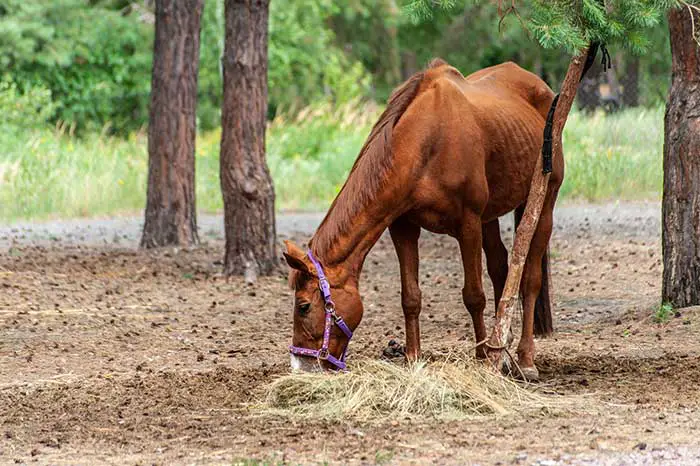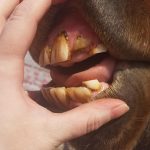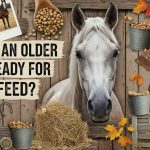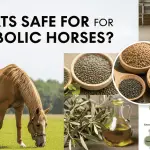Have you ever noticed your horse showing signs of discomfort or changes in behavior? It might be due to hindgut problems, a common issue that many horse owners face without realizing.
Understanding these problems is crucial for maintaining your horse’s health and happiness. You want the best for your equine friend, but sometimes, hidden issues like hindgut disturbances can go unnoticed, leading to bigger health concerns. Imagine being able to spot the symptoms early and prevent potential complications.
This article will guide you through the essential aspects of hindgut health, helping you ensure your horse’s comfort and well-being. Dive in to discover how you can make a significant difference in your horse’s life.
Hindgut Anatomy
Hindgut anatomy in horses is crucial for digestion and nutrient absorption. Understanding its function helps identify problems like colic or ulcers. Proper care and diet can prevent these issues, ensuring a healthy digestive system.
Understanding the anatomy of a horse’s hindgut can be an eye-opener for any horse enthusiast or caretaker. It plays a critical role in maintaining your horse’s health and well-being. When you grasp how the hindgut functions, you can make more informed decisions about your horse’s diet and care.
Structure And Function
The hindgut comprises two main parts: the cecum and the colon. These sections are vital for processing food that passes through the horse’s digestive system. The cecum acts like a fermentation vat where microbes break down fibrous materials. The colon follows the cecum and is responsible for absorbing water and nutrients. Its long length gives it ample time to extract the maximum amount of nutrients. Together, these components ensure that your horse gets the energy needed from its feed. The hindgut is a busy place. It houses billions of bacteria that help break down complex carbohydrates. This microbial activity is crucial for producing volatile fatty acids, which provide energy.
Role In Digestion
The hindgut is not just a passive participant in digestion. It plays an active role by fermenting fibers, converting them into energy. This process is essential for horses, especially those on high-fiber diets. Think about what happens when your horse grazes on grass or hay. The hindgut works tirelessly to convert this fibrous material into digestible nutrients. Without this process, your horse could miss out on essential energy sources. Have you ever noticed changes in your horse’s behavior after a diet adjustment? This could be linked to hindgut health. A happy hindgut often leads to a happy horse. It’s important to monitor your horse’s diet and ensure it supports a healthy digestive system. Understanding the hindgut is not just for veterinarians. With this knowledge, you can make better choices for your horse. Keep asking questions and learning to ensure your horse thrives.
Common Hindgut Disorders
Horses often face hindgut issues like colitis, ulcers, and acidosis. These conditions disrupt digestion and nutrient absorption. Identifying symptoms early ensures better management and care for your horse’s health.
Understanding the intricacies of a horse’s digestive system is crucial for every equestrian enthusiast. The hindgut, a vital part of this system, often harbors disorders that can affect your horse’s health significantly. Recognizing these common hindgut disorders can empower you to take swift action and ensure your horse remains healthy and active.
Colitis
Colitis, an inflammation of the colon, can be a real challenge. It often results from stress, dietary changes, or infections. You might notice diarrhea, lethargy, or even a loss of appetite in your horse. One memorable instance was when my horse, Belle, suddenly stopped eating and displayed a lack of energy. After consulting with the vet, we found it was colitis triggered by a new feed. This taught me the importance of gradual dietary transitions. Are you aware of the subtle signs your horse may show during such episodes? Understanding these can be a lifesaver.
Ulcerative Conditions
Ulcers are another common issue in a horse’s hindgut. They often stem from high grain diets or stress. Symptoms might include weight loss, poor performance, or colic. A friend once shared how her horse’s performance dipped unexpectedly during competitions. It turned out to be ulcers, exacerbated by the stress of traveling. Could your horse be facing similar conditions due to environmental stress? Keeping a keen eye on behavior changes is crucial.
Impaction Issues
Impaction occurs when the intestines become blocked, often due to dehydration or high fiber intake. You might notice constipation or abdominal pain in your horse. In one event, I had to deal with my horse, Jack, showing signs of discomfort after a dry spell. Increasing his water intake and adjusting his diet resolved the issue. Are you ensuring your horse gets enough water, especially during dry seasons? This simple step can prevent severe health problems. Recognizing these disorders early can make all the difference in your horse’s well-being. Stay vigilant and responsive to any changes in your horse’s behavior or health. Your proactive approach can keep your equine friend in top form.
Symptoms Of Hindgut Problems
Understanding the symptoms of hindgut problems in horses is crucial. These signs can vary, making it challenging to pinpoint the issue. Early detection is vital for effective management and treatment. Paying attention to behavioral and physical changes can help identify these issues.
Behavioral Changes
Horses with hindgut problems often display unusual behaviors. They might seem irritable or restless. A typically calm horse may become more aggressive. Changes in eating habits can also occur. Some horses may refuse food or eat less than usual. Watch for signs of discomfort during feeding times.
Physical Indicators
Physical signs are often more visible in horses with hindgut issues. Weight loss is a common symptom. Even with normal feeding, the horse may appear thinner. Frequent diarrhea or loose stools are significant indicators. Abdominal pain may cause the horse to paw at the ground or roll frequently. A dull coat and lethargy might also signal a problem. Observing these signs early helps in managing the condition effectively.
Diagnosis Techniques
Understanding hindgut problems in horses is crucial for their health. Early diagnosis techniques play a key role in managing these issues. By identifying symptoms promptly, effective treatment can begin. Let’s explore the methods used to diagnose hindgut problems.
Veterinary Assessment
Veterinary assessment forms the first step in diagnosing hindgut issues. Veterinarians perform physical exams to check for signs of discomfort. They palpate the abdomen to detect pain or swelling. Observing the horse’s behavior gives insights into possible problems. A thorough medical history helps in understanding the horse’s condition better.
Diagnostic Tools
Diagnostic tools are essential for precise hindgut assessments. Ultrasound scans provide images of the intestines and other organs. They help in identifying blockages or abnormal growths. Blood tests reveal inflammation or infections affecting the hindgut. Fecal tests detect parasites and assess digestive efficiency.
Advanced techniques like endoscopy offer a detailed view inside the gut. These tools aid in pinpointing specific problems. Accurate diagnosis leads to targeted treatments, ensuring better recovery for the horse.
Treatment Options
When your horse is facing hindgut problems, finding the right treatment options is crucial for their health and comfort. It’s not just about addressing symptoms; it’s about understanding what works best for your horse. Let’s dive into the various treatment options available, and see how each one can be tailored to meet your horse’s specific needs.
Medications
Medications can play a key role in managing hindgut issues in horses. They might include anti-inflammatory drugs to reduce swelling, or antibiotics to tackle infections.
But remember, medications should be prescribed by a veterinarian. They can assess your horse’s condition and suggest the right dosage and type.
Have you ever noticed a rapid improvement in your horse after starting a medication? It’s that swift relief that underscores the importance of professional guidance.
Dietary Adjustments
Dietary changes are often the first step in treating hindgut problems. Adjusting your horse’s diet can help manage symptoms and promote better gut health.
Consider introducing more fiber-rich feed. This can aid digestion and soothe the gut lining.
Have you tried feeding your horse smaller, more frequent meals? This simple change can make a significant difference in their digestive health.
Surgical Interventions
Surgical options are considered when other treatments don’t work. These procedures aim to address serious underlying issues.
It’s a big decision and should be made after careful consultation with a veterinarian. They can help you understand the risks and benefits.
What would you do if surgery was the only option left? It’s a question that requires serious thought, balancing potential outcomes with your horse’s well-being.
Each treatment option comes with its own set of considerations. Your role is to ensure your horse receives the best care possible, and sometimes that means asking the hard questions and exploring all possibilities.
Preventive Measures
Hindgut problems in horses can cause serious health issues. Regular dental check-ups and a balanced diet help prevent these problems. Monitoring feed quality and ensuring clean water access also play crucial roles in maintaining a healthy digestive system.
Understanding the intricacies of hindgut health in horses is essential for every horse owner. The good news is that many problems can be prevented with proper care. By focusing on preventive measures, you can significantly enhance your horse’s overall health and well-being.
Diet Management
Diet plays a crucial role in maintaining your horse’s hindgut health. Ensure your horse gets enough fiber by providing ample hay or pasture. It’s also vital to balance their diet with the right mix of grains and supplements. Avoid sudden changes in your horse’s diet. Sudden dietary shifts can upset the balance of good bacteria in the hindgut. If you need to change feed, do it gradually over a week to allow your horse’s digestive system to adjust. Always ensure your horse has access to clean, fresh water. Dehydration can lead to impaction colic, a common hindgut issue. Encourage your horse to drink by adding salt to their diet or providing a salt lick.
Regular Check-ups
Regular veterinary check-ups are essential for early detection of hindgut problems. Schedule routine visits to monitor your horse’s digestive health. A professional can spot signs of issues before they become severe. Keep a close eye on your horse’s behavior and physical condition between vet visits. Changes in appetite, weight, or manure can indicate hindgut distress. If you notice anything unusual, consult your veterinarian immediately. Consider regular dental check-ups as well. Proper dental care ensures your horse can chew their food effectively, promoting better digestion. This simple step can prevent many hindgut complications. Preventive measures in horse care are not just about routine. They require attention to detail and a proactive approach. What steps will you take today to safeguard your horse’s health?
Impact On Horse Health
Horses often face health issues due to hindgut problems. Digestive troubles can lead to colic, weight loss, and poor performance. Ensuring a balanced diet helps maintain their gut health.
Understanding hindgut problems in horses is crucial for any horse owner. The hindgut plays a significant role in your horse’s overall health. Issues in this area can have profound effects on their well-being and performance.
Performance Effects
Hindgut problems can severely impact a horse’s performance. You might notice a decrease in energy levels. A horse with digestive discomfort is less likely to perform at its peak. Consider a time when your horse seemed to lack stamina during a ride. This could be an early sign of hindgut issues. Addressing this promptly can prevent further decline in performance. Imagine your horse refusing jumps or struggling with basic exercises. These are signs that should not be ignored. Improving gut health could be the key to restoring their agility and enthusiasm.
Long-term Health Risks
Ignoring hindgut problems can lead to serious health risks. Horses may suffer from chronic colic or laminitis. These conditions can be painful and debilitating. Think about the long-term costs of veterinary care if a problem goes untreated. Early detection and intervention can save you and your horse from long-term distress. What steps can you take to ensure your horse remains healthy? Regularly monitor their behavior and consult with a vet if you notice changes. A proactive approach can safeguard their health for years to come.
Role Of Nutrition
Proper nutrition plays a vital role in preventing hindgut problems in horses. A balanced diet helps maintain digestive health, reducing issues like colic and ulcers. High-fiber diets and controlled starch intake support a healthy hindgut environment.
Understanding the role of nutrition in maintaining your horse’s hindgut health is crucial. Horses rely on a delicate balance of nutrients to keep their digestive systems running smoothly. If their diet isn’t right, it can lead to serious issues. Many horse owners have witnessed firsthand the importance of feeding correctly. The difference between a thriving horse and one with digestive problems often comes down to what goes into their feed bucket.
Fiber Importance
Fiber is a cornerstone of a horse’s diet. It helps maintain a healthy digestive system and prevents issues like colic. Horses have evolved to graze on high-fiber forage throughout the day. This natural grazing keeps their hindgut moving and healthy. Are you providing enough roughage for your horse? Consider the types and amounts of hay and grass they consume daily. Ideally, horses should eat around 1-2% of their body weight in forage each day.
Supplement Choices
Selecting the right supplements can support your horse’s hindgut health. However, not all supplements are created equal. It’s crucial to choose those that specifically benefit the digestive system. Probiotics and prebiotics can be particularly beneficial. They help maintain a healthy balance of bacteria in the hindgut. But, how do you know which ones are right for your horse? Always consult with a veterinarian or equine nutritionist. They can provide guidance tailored to your horse’s specific needs. Think about your own experiences. Have you noticed a change in your horse’s health with different feeding strategies? These insights can guide you in making the best nutritional choices. Remember, small changes in diet can lead to big improvements in your horse’s overall well-being.
Case Studies
Understanding hindgut problems in horses can be challenging. Case studies offer valuable insights. They show real-life examples. These examples highlight challenges and solutions. By examining these cases, horse owners can learn practical lessons. This knowledge helps in managing and preventing hindgut issues effectively.
Real-life Examples
A horse named Bella showed severe weight loss. Despite a healthy diet, her condition worsened. A veterinarian diagnosed hindgut acidosis. Bella’s case was unique. Her diet included high-starch grains. This led to digestive imbalance. With dietary changes, Bella improved. Her story teaches us about diet’s role in gut health.
Another case involved Max. Max experienced frequent colic episodes. His owner was puzzled. After testing, hindgut ulcers were found. Treatment involved medication and a fiber-rich diet. Max’s health improved significantly. His case emphasizes the importance of early diagnosis and treatment.
Lessons Learned
From these cases, we learn vital lessons. Diet plays a crucial role. High-starch diets can harm the hindgut. Fiber-rich diets support gut health. Early diagnosis is key. It prevents complications and ensures timely treatment.
Regular veterinary check-ups are essential. They help detect issues early. Understanding horse behavior is also important. Changes in appetite or weight could indicate gut problems. Observing these signs can lead to early intervention.
These cases show real challenges. They offer practical solutions. By learning from them, horse owners can better manage hindgut health. They can ensure their horses remain healthy and happy.

Credit: www.succeed-vet.com
Frequently Asked Questions
What Causes Hindgut Problems In Horses?
Hindgut problems in horses often stem from poor diet, stress, and insufficient fiber. High starch diets can disrupt gut health, leading to issues like colic or diarrhea. Stress from changes in environment or routines can exacerbate these problems. Ensuring a balanced diet rich in fiber is crucial for prevention.
How Can You Identify Hindgut Issues?
Identifying hindgut issues involves observing symptoms like diarrhea, weight loss, and colic. Behavioral changes, such as irritability or reduced performance, can also indicate problems. Regular veterinary check-ups are essential for early detection. Monitoring dietary intake and ensuring adequate fiber can help maintain gut health.
What Is The Role Of Fiber In Horse Digestion?
Fiber plays a crucial role in horse digestion by aiding nutrient absorption and promoting gut motility. It helps maintain a healthy balance of gut bacteria, preventing issues like colic. High-fiber diets support overall digestive health, improving nutrient uptake and reducing the risk of hindgut problems.
Can Stress Affect Horse’s Hindgut Health?
Yes, stress can significantly impact a horse’s hindgut health. Stress alters gut bacteria balance, leading to issues like colic and diarrhea. Environmental changes, social disruptions, or dietary adjustments can increase stress levels. Implementing calming routines and ensuring a consistent diet can mitigate these effects.
Conclusion
Understanding hindgut problems in horses is crucial for their well-being. These issues can affect a horse’s health significantly. Regular check-ups and balanced diets help prevent these problems. Early detection is key to effective treatment. Always consult a vet for any concerns.
Keeping your horse’s gut healthy ensures better performance. Simple care routines make a big difference. Happy horses lead to happy owners. Watch for signs of discomfort. Addressing issues early saves stress later. Remember, a healthy horse is a happy horse.
Prioritize their gut health for a better bond.






